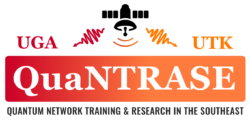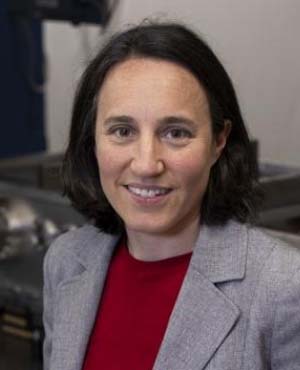Melanie Reber
Department of Chemistry
Assistant Professor of Chemistry
EDUCATION
Post-Doctoral Associate, Stony Brook University, Stony Brook, NY 2016
PhD Chemical Physics, University of Colorado Boulder and JILA, Boulder, CO 2012
BA Chemistry, Macalester College, St. Paul, MN 2005 Cum Laude
The Reber lab uses fiber-laser frequency combs to do ultrafast chemistry. Ultrafast spectroscopy is used for real-time tracking of dynamics in quantum mechanical systems on the femtosecond (10-15s) timescale. We employ a newly-developed technique called Cavity-Enhanced Transient Absorption Spectroscopy to increase the sensitivity of ultrafast absorption spectroscopy. We use ultrafast fiber-laser frequency combs and couple them to external enhancement cavities to both increase the power and effective absorption pathlength, thus giving signal enhancements of several orders of magnitude over traditional transient absorption spectroscopy. This technique allows us to study samples in molecular beams on the femtosecond timescale with transient absorption spectroscopy. Before the development of this technique, ultrafast transient absorption was limited to concentrated condensed phase samples and study of gas phase samples generally required an indirect probe, such as measuring the energy of an ejected electron, or was limited to molecules and states that fluoresce. Now, not only can we now do the same experiment on condense phase molecules as gas phase molecules via transient absorption spectroscopy, we are able to directly probe the molecular states undergoing the dynamics we wish to study.
We are currently building up the fiber lasers and cavity-enhanced transient absorption spectrometer with unique frequency tuning capabilities. We will combine this with a molecular beam source to create a relatively cold source of molecules and the ability to make clusters, radicals, and other designer molecules. One research direction will study the fundamentals of light-harvesting molecules, with a focus on the process of singlet fission, in which one absorbed photon becomes two excited electrons. Single fission is already starting to be used to increase the efficiency of solar cells, even though it is not well understood. We aim to look at model systems and understand the fundamental mechanisms of singlet fission. A second direction of research will be to study ultrafast dynamics of combustion radicals. Eventually we will make infrared light to look at ultrafast vibrational dynamics in a wide range of molecular systems.
Cavity-Enhanced Transient Absorption Spectroscopy is widely applicable as an ultrafast technique since it requires nothing more than an absorbing state to probe any ultrafast dynamics. By combining a large wavelength tuning range, we can probe many systems from UV-vis photochemistry to ultrafast vibrational dynamics in the IR. With a molecular beam we can study not just stable compounds, but can make designer molecules (such as clusters) and short-lived molecules (such as radicals) and can study those as well. Additionally, the instrument is general enough to be able to do multidimensional spectroscopy with only a few small modifications.
X. L. Li, M. A. R. Reber, C. Corder, Y. Chen, P. Zhao, T. K. Allison. High-power ultrafast Yb:fiber laser frequency combs using commercially available components and basic fiber tools. Rev. Sci. Inst. 2016; 87: 093114.
M. A. Roberts Reber, Y. Chen, and T. K. Allison. Cavity-enhanced ultrafast spectroscopy: ultrafast meets ultrasensitive. Optica 2016; 3:311.
M. A. Roberts, E. N. Sharp-Williams, and D. J. Nesbitt. High-resolution direct-absorption spectroscopy of hydroxymethyl radical in the CH symmetric stretching region. J. Phys. Chem. A. 2013; 117:7042-7049.
M. A. Roberts, C. Savage, F. Dong, E. N. Sharp-Williams, A. B. McCoy, and D. J. Nesbitt. Sub-Doppler infrared spectroscopy of CH2D radical in a slit supersonic jet: Isotopic symmetry breaking in the CH stretching manifold. J. Chem. Phys. 2012; 136:234308.
E. N. Sharp-Williams, M. A. Roberts, and D. J. Nesbitt. Dark state vibronic coupling in the A2Π-X2Σ+ band of ethynyl radical via high resolution infrared absorption spectroscopy. Phys. Chem. Chem. Phys. 2011; 13:17474-17483.
E. N. Sharp-Williams, M. A. Roberts, and D. J. Nesbitt. High resolution slit-jet infrared spectroscopy of ethynyl radical: 2Π-2Σ+ vibronic bands with sub-Doppler resolution. J. Chem. Phys. 2011; 134:064314.
E. N. Sharp, M. A. Roberts, and D.J. Nesbitt. Rotationally resolved infrared spectroscopy of jet-cooled phenyl radical in the gas phase. Phys. Chem. Chem. Phys. 2008; 10:6592-6596. cover art
F. Dong, M. Roberts, and D. J. Nesbitt. High-resolution infrared spectroscopy of jet cooled vinyl radical: symmetric CH2 stretch excitation and tunneling dynamics. J. Chem. Phys. 2008; 128:044305.
D. J. Nesbitt, E. S. Whitney, M. Roberts, and C. Savage. Spectroscopy in slit supersonic jet discharges: fine and hyperfine structure calculations for asymmetric top radicals with multiple nuclear spins. Molecular Physics 2007; 105:467-475. J. M. Brown special issue invited paper
M. A. Roberts, C. G. Alfonzo, K. J. Manke, W. M. Ames, D. B. Ron, and T. D. Varberg. Hyperfine structure in the electronic spectrum of ReO. Molecular Physics 2007; 105:917-921. J. M. Brown special issue invited paper
Vibrational Spectroscopy Gordon Conference Poster Competition Winner 2014
Colorado Measurement Science and Engineering Graduate Fellowship, CU Department of Physics 2012
Colorado Photonics Industry Student Poster Competition, First Place Entry 2007
National Science Foundation Integrative Graduate Education and Research Traineeship (NSF-IGERT), Optical Science and Engineering Program (OSEP) 2005-2008
National Science Foundation Graduate Research Fellowship (NSF-GRF), Honorable Mention 2004
Summer Research Grant, Macalester College Chemistry Department 2004
Macalester College Varsity Track and Field Team Captain 2003-2004

